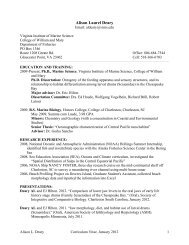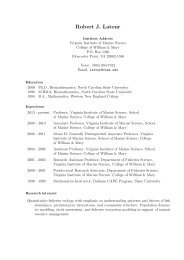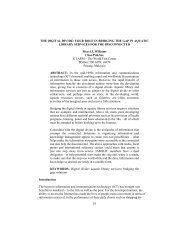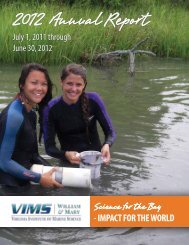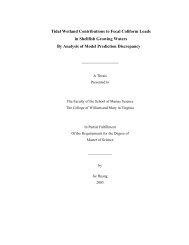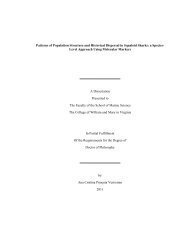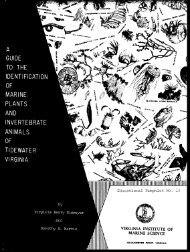Behaviors of the pelagic red crab Pleuroncodes planipes observed ...
Behaviors of the pelagic red crab Pleuroncodes planipes observed ...
Behaviors of the pelagic red crab Pleuroncodes planipes observed ...
Create successful ePaper yourself
Turn your PDF publications into a flip-book with our unique Google optimized e-Paper software.
<strong>Behaviors</strong> <strong>of</strong> <strong>Pleuroncodes</strong> <strong>planipes</strong> 77launching from <strong>the</strong> bottom <strong>of</strong> <strong>the</strong> aquarium.Comparisons <strong>of</strong> field observations <strong>of</strong> crustaceanactivity to observations <strong>of</strong> laboratory activitypatterns have shown that <strong>the</strong> two are notnecessarily <strong>the</strong> same, and that many organismsmodify <strong>the</strong>ir behavior in captivity (Chatterton& Williams, 1994). This seems to be <strong>the</strong> casewith this hovering behavior <strong>of</strong> P. <strong>planipes</strong> in <strong>the</strong>aquarium. We have not seen any evidence <strong>of</strong>hovering in any in situ observations (Tulipani,2005).Yet Kato (1974) suggested that <strong>red</strong> <strong>crab</strong>smaintain <strong>the</strong>ir position in <strong>the</strong> water column,akin to hovering, by alternating between activelyswimming and slowly sinking. Analysis<strong>of</strong> in situ video <strong>of</strong> <strong>Pleuroncodes</strong> <strong>planipes</strong> supports<strong>the</strong>se conclusions (Tulipani, 2005) where<strong>the</strong>y swim rapidly upward with several tail-flipsand <strong>the</strong>n slowly sink with limbs extended. Theslow sinking was <strong>the</strong> only passive locomotorybehavior since <strong>the</strong> <strong>red</strong> <strong>crab</strong>s did not move<strong>the</strong>ir pereopods or chelipeds while <strong>the</strong>y sank.Movement <strong>of</strong> <strong>the</strong>ir mouthparts indicated typicalfeeding behavior while sinking, <strong>observed</strong>by Kato (1974) and seen on in situ videotapes(Tulipani, 2005). The repeated surface swimmingand sinking pattern probably enables <strong>the</strong>large swarm <strong>of</strong> <strong>crab</strong>s to feed without expendingmuch energy once <strong>the</strong>y have reached <strong>the</strong> surface.O<strong>the</strong>r smaller crustaceans, such as copepods(Buskey et al., 1996) and mysids (Buskey,1998), also form large aggregations in surfaceswaters yet are usually continually swimmingto maintain <strong>the</strong>ir position and expending muchenergy to do so. Feeding while sinking is probablybeneficial energetically for <strong>the</strong> <strong>red</strong> <strong>crab</strong>sbecause once <strong>the</strong>y reach <strong>the</strong> surface, <strong>the</strong>y stopswimming and simply float before beginning<strong>the</strong>ir slow, passive descent. After each sinkingsegment, <strong>the</strong>y only need to swim a short time toreach <strong>the</strong> surface again. This may be analogousto blue <strong>crab</strong>s (Callinectes sapidus) using tidalcycles to assist long distance travel, migratingup to 1000m day –1 to reach spawning areas (Full& Weinstein, 1992; Tankersley et al., 1998) apotential energetic benefit. It is particularly evidentin gravid female Callinectes sapidus whoapparently use ebb-tides to travel seaward to releaseembryos and <strong>the</strong>n use flood-tides to returnup-estuary afterwards (Tankersley et al.1998).Thus, it appears that <strong>Pleuroncodes</strong> <strong>planipes</strong>utilize <strong>the</strong>ir complex suite <strong>of</strong> locomotory behaviors,especially <strong>the</strong> unique alternation <strong>of</strong>efficient jet-propelled swimming and low costslow sinking patterns, to feed more efficiently.Analysis <strong>of</strong> <strong>the</strong>ir body design and fluid dynamicparameters support <strong>the</strong> contention that<strong>the</strong>y are very well adapted to active swimmingand passive sinking (Tulipani, 2005). Thoughlocomotion accounts for only 15% <strong>of</strong> <strong>the</strong>ir totalrepertoire, <strong>pelagic</strong> <strong>red</strong> <strong>crab</strong>s show a clear synergybetween <strong>the</strong>ir functional morphology and<strong>the</strong>ir behaviors. They may not appear that differentfrom o<strong>the</strong>r decapods in <strong>the</strong>ir stationarybehaviors but <strong>the</strong>ir unique swimming modes set<strong>the</strong>m apart from o<strong>the</strong>r <strong>crab</strong>s.Acknowledgements.—Special thanks go toLisa M. Baird, Mary Sue Lowery, and Anne A.Sturz for <strong>the</strong>ir editorial assistance and criticalreview <strong>of</strong> this manuscript, as well as to MissVanessa Ruiz for <strong>the</strong> wonderful illustrationsincluded in this paper as well as my Master’s<strong>the</strong>sis. We would also like to thank <strong>the</strong> Schoolfor Field Studies staff in Puerto San Carlos,BCS, Mexico for <strong>the</strong>ir logistic support. Fundingfor this research was provided by <strong>the</strong> MarineScience Dept. at <strong>the</strong> University <strong>of</strong> San Diego,<strong>the</strong> TransBorder Institute at <strong>the</strong> University <strong>of</strong>San Diego, a Hannon Foundation fellowship(DCT) and <strong>the</strong> Coca-Cola Foundation.LITERATURE CITEDArnott, S. A., Neil, D. M., & Ansell, A. D., 1998.Tail-flip mechanism and size-dependentkinematics <strong>of</strong> escape swimming in <strong>the</strong>brown shrimp Crangon crangon. Journal <strong>of</strong>Experimental Biology, 201:1771–1784.Aurioles-Gamboa, D., 1992. Inshore-<strong>of</strong>fshoremovements <strong>of</strong> <strong>pelagic</strong> <strong>red</strong> <strong>crab</strong>s <strong>Pleuroncodes</strong><strong>planipes</strong> (Decapoda, Anomura, Gala<strong>the</strong>idae) <strong>of</strong>f<strong>the</strong> Pacific Coast <strong>of</strong> Baja California Sur, Mexico.Crustaceana, 62:71–84.Aurioles-Gamboa, D., Castro-González, M. I., &Pérez-Flores, R., 1994. Annual mass strandings<strong>of</strong> <strong>pelagic</strong> <strong>red</strong> <strong>crab</strong>s, <strong>Pleuroncodes</strong> <strong>planipes</strong>(Crustacea: Anomura: Gala<strong>the</strong>idae), in BahíaMagdalena, Baja California Sur, Mexico. Fishery



